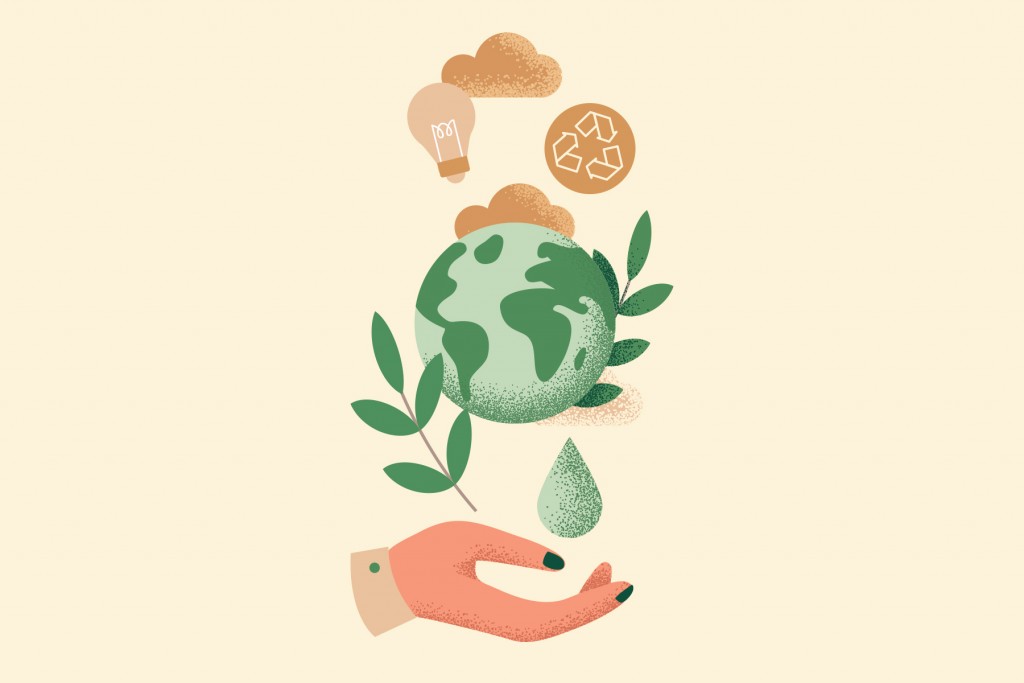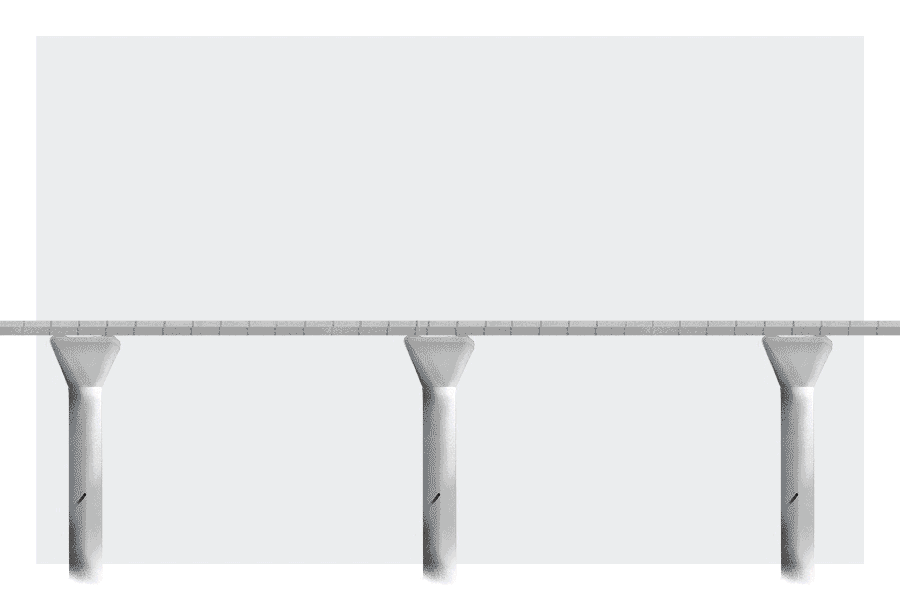The Cost of Climate Change in Hawaii
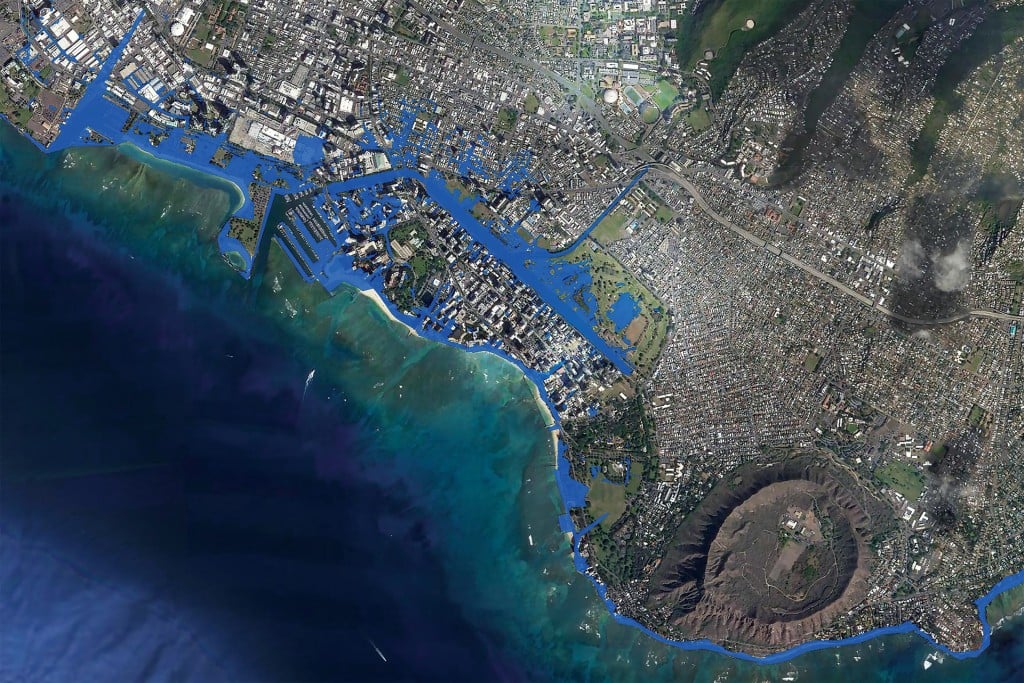
The world is literally changing and here are six issues we need to understand so we can begin calculating the costs and consequences of climate change and prepare for them. We won’t be able to save everything, so all of Hawaii should join in the discussion about where to focus our money and efforts.
Like others in Hanalei, Joel Guy went to bed the night of April 15 expecting the rain to subside. Instead, he and his wife were awakened at 2 a.m. by the sounds of thunder and their baby screaming. Out of a broken window, he saw their yard was now a river, the water several feet high, lapping against their raised home. “People were out there on Jet Skis and paddling surfboards up and down the roads, evacuating others in the pitch black. What was normally a street had water 6 feet deep and fast-moving currents. It was just a horrifying experience,” Guy says. By morning, cowboys on Jet Skis were rounding up buffalo that had been washed down a valley all the way to the reef. Within 24 hours, 50 inches of rain fell in Hanalei.
As record-breaking as the event was, however, climate experts were not surprised. Out of 27 extreme weather events in 2016, researchers for the American Meteorological Society have correlated 21 of them to human-caused climate change.“The probability of these intense rainfall events increases as the atmosphere grows warmer,” says Chip Fletcher, vice chair of the Honolulu Climate Change Commission.
In Hawaii, 2015 and 2016 were the hottest years on record. Worldwide, we are on a path to an increase of 2.2 to 3.4 degrees Celsius by the end of the century (5.2 to 6.1 degrees Fahrenheit). Scientists agree that our warming atmosphere is caused by human-made emissions of carbon dioxide, primarily through the burning of fossil fuels and cutting down of carbon-absorbing forests. Excess heat trapped by carbon dioxide, a greenhouse gas, causes dramatic changes in the ecosystem, including temperature rise, sea-level rise, ocean expansion and extreme weather events like the one in Hanalei.
“These rainfall events are weather. Climate change doesn’t cause weather. But climate change does cause these weather events to grow in severity and therefore cause more damage. We’re confident in saying that the magnitude of events that took place in Hawaii this past spring are consistent with what climate change is going to continue to bring to the state,” says Fletcher, who is also associate dean of UH Manoa’s School of Ocean and Earth Science and Technology
Although we know with high certainty what climate change is doing and will do to our environment, we don’t know how much it will cost. We have some estimates, but our state has yet to produce a comprehensive analysis of the economic impact on our resources, infrastructure, businesses, social services and households. The economists, scientists, state leaders and infrastructure planners interviewed for this piece say such an analysis is an extremely complex task. But they also stress that if we don’t undertake it, the state will suffer financially in the decades to come.
Josh Stanbro, Honolulu’s chief resilience officer and executive director of the city’s Office of Climate Change, Sustainability and Resiliency, says: “We can handle a $15 million hit here and a $20 million hit there. But then, all of a sudden, you’re dealing with costs that were never budgeted in the books. And it’s all ramping up.
“This is where climate change doesn’t kill with one knockout blow. It kills by 1,000 cuts.”
In this article, leaders across the state’s public, private and scientific spheres share six of the most critical issues we need to understand about what climate change will cost Hawaii in the coming decades.
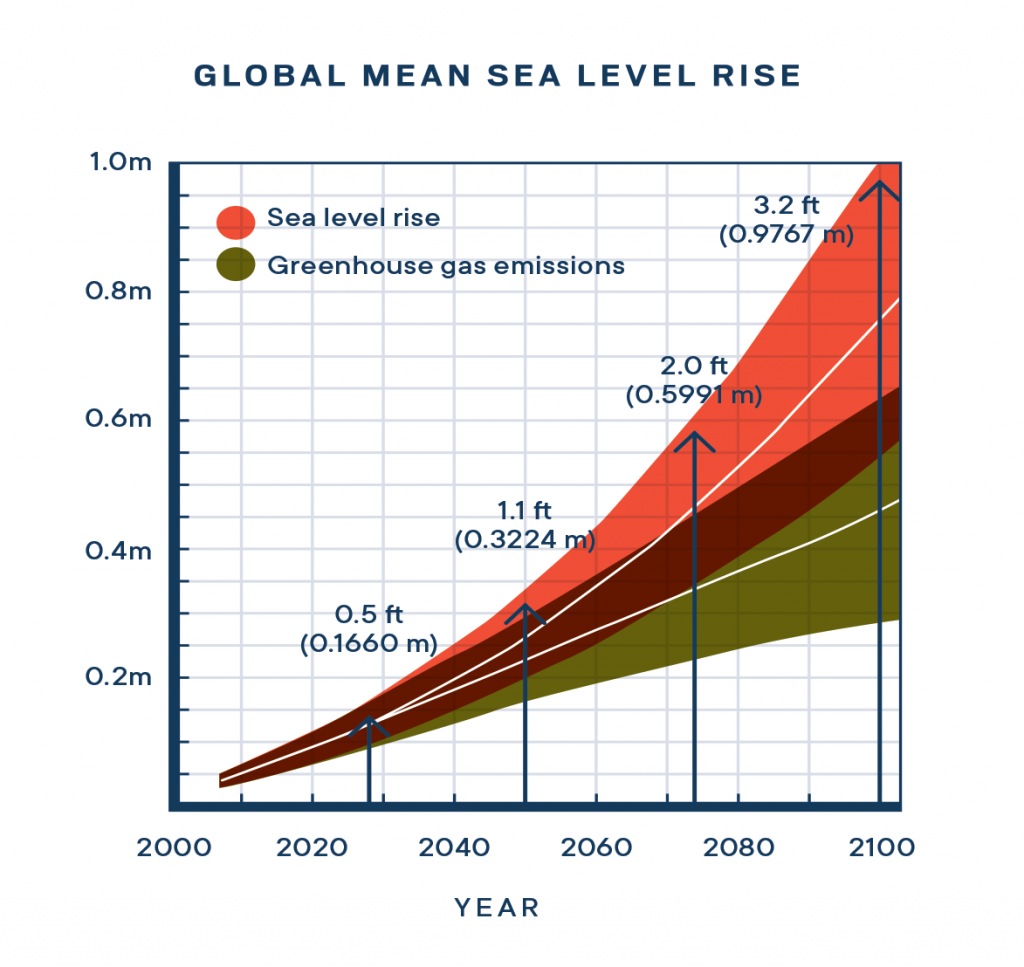
Projected rate of global mean sea level rise under different greenhouse gas emissions scenarios from the Fifth assessment report of the Intergovernmental Panel on Climate Change.
Make our analysis actionable
It is hard to be nonchalant about the future of our coasts after playing around with the Hawaii Sea Level Rise Viewer. An online resource, it visually illustrates what areas of the state will be affected as warming temperatures and the melting of ice sheets and glaciers increase the volume of the ocean.
When, as predicted, sea levels rise 3.2 feet by the end of the century or even as soon as 2060, Waikiki Beach, Ala Wai Boat Harbor and Ala Moana Beach Park will all be flooded. Across the state, 25,800 acres of land and 6,500 structures near the shoreline will be compromised or unusable and 20,000 shoreline residents displaced.
The Hawaii Sea Level Rise Vulnerability and Adaptation Report estimates the lost value of flooded structures and land at over $19 billion. The 2017 report is the first in the state to connect the science of climate change to specific economic consequences.
Makena Coffman, director of the Institute for Sustainability and Resilience at UH Mānoa and chair of the Honolulu Climate Change Commission, describes its importance: “That report, as well as some other work on the physical impacts, are the important grounding studies that then allow us to ask the question: Now that we know more about the physical side of what happens, what about the social and economic sides? Because physical impacts will dictate what the scope of the problem is.”
Sam Lemmo, administrator for the state DLNR’s Office of Conservation and Coastal Lands, says a key motive behind the study was to marry science with action-oriented information.
“I thought, we’ve got to stop talking about it and debating it. We just have to sit down and produce something that we can then use to make the changes necessary to reduce the impact sea level rise is going have on us in the future. We wanted to give people the tools to say, ‘We now have to do something about this,’ ” says Lemmo, whose office led development of the sea level rise report.
The Honolulu Climate Change Commission made recommendations based on the report and Mayor Kirk Caldwell acted on those recommendations in July by requiring all city departments and agencies to assess their resources and propose strategies for addressing vulnerable facilities.
Honolulu Board of Water Supply Water Resources Division program administrator Barry Usugawa is especially focused on 76 miles of pipeline in the flood zone and thus vulnerable to seawater corrosion. While he estimates the cost for updating these pipelines at about $300 million, he emphasizes this is just the start.
“We have major pipelines along highways like Kamehameha and Farrington. If these coastal roads are damaged, they’ll damage our pipes too,” says Usugawa.
Edwin Sniffen, the state Department of Transportation’s deputy director for highways, has also come to some sobering conclusions. “When we start looking at the system that we have and the projected sea level rise, we’re looking at about 15 percent of our state’s highway system being impacted in some way, shape or form. That’s a big amount of roadway and bridges and infrastructure we have to either raise up, relocate or address in some way, shape or form.”
His preliminary estimate: $15 billion.
“That number scares the heck out of me,” Sniffen says, noting that his team’s annual budget of $280 million is less than 2 percent of that figure.
“But if we don’t address this, our drives along Kamehameha Highway in Kaaawa are gone. The homes that are out there will no longer be serviced. The west side of Maui that makes up 30 percent of the income on the island, will no longer be accessible. You won’t be able to get to Kaanapali anymore,” Sniffen says.
NOAA regional climate services director John Marra, who works for the National Centers for Environmental Information and is based in Honolulu, hopes to see more analyses that take a systems view, looking at how different sectors will be impacted by all of the outcomes of climate change, not just sea level rise.
“If you take tourism and approach it from that perspective, you can ask what is the thing I should be most concerned about first? Is it sea level rise, changes in temperature that make it less comfortable, or reef damage because the ocean is warmer? For someone in the tourist sector, I can then see what my weakest link is. Am I losing more visitors because it’s hotter and will I have to spend more on air conditioning? Or is it that the rising sea level means I can’t put a towel on the beach? If you put the focus on only one physical process, you may be missing the thing that’s actually the key issue.
“It’s the cumulative impact of all of these things. Let’s bring the technical information that gets generated in silos or disciplines into a more holistic framework that society can take action on,” says Marra.
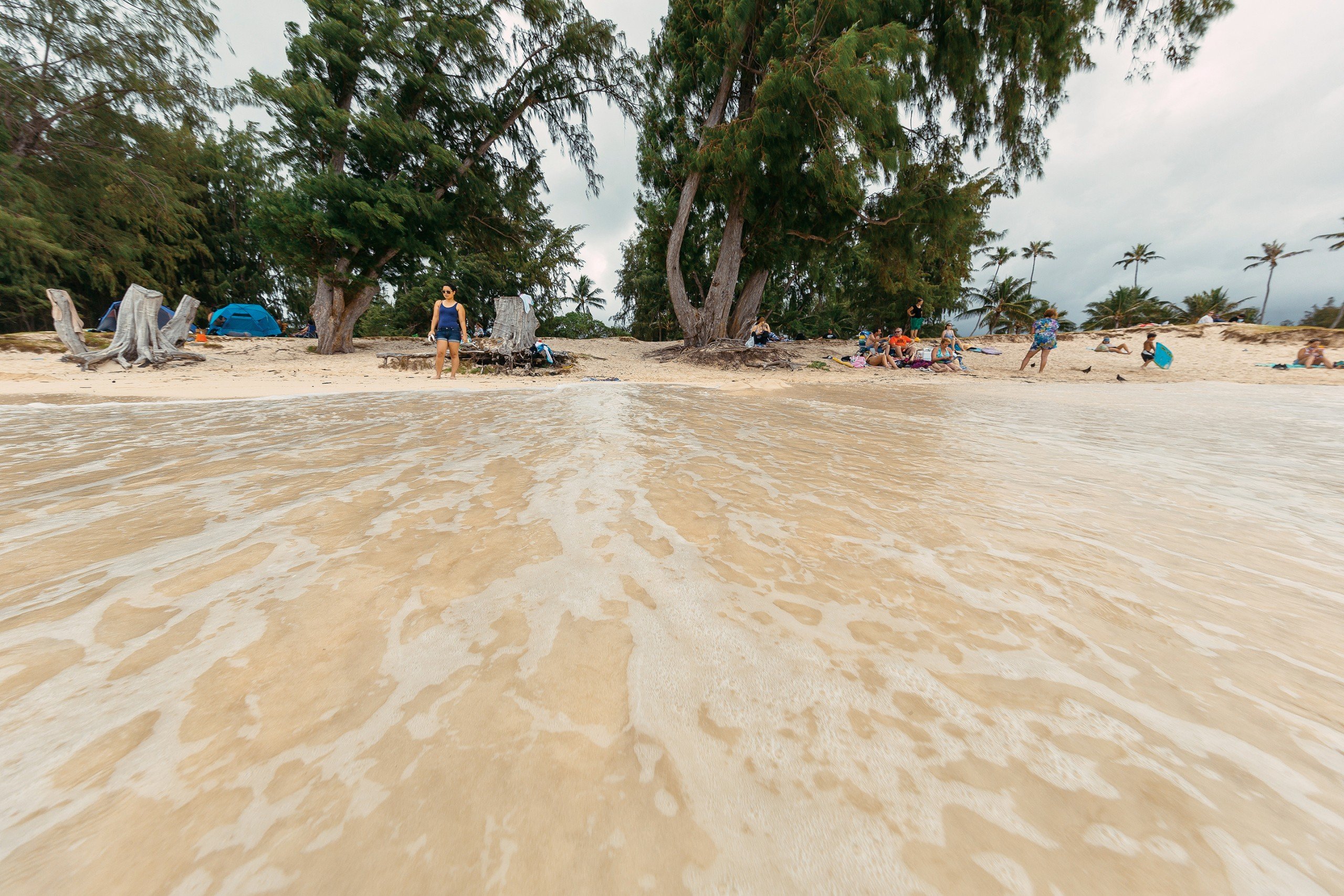
King tides at Kailua Beach in July 2017 brought the water line as far up the shore as the ironwood trees. | Photo: Aaron Yoshino
Know that each strategy has its trade-offs
Waikiki is, in many ways, ground zero for the difficult discussions around what we should do. Out of $15.6 billion in visitor spending in 2016, $2 billion was specifically related to the state’s most iconic beach destination, making it an indisputable economic priority.
“What is our coastal strategy? Are we going to retreat from the shoreline? Or are we going to harden our infrastructure on the coast? Or are we going to wait and see what happens? These are all very different responses with different economic impacts,” says Denise Konan, dean of the College of Social Sciences at UH Manoa and founding director of the Center for Sustainable Coastal Tourism at the UH Sea Grant College Program.
These questions are made even more immediate by the fact that Waikiki Beach is now largely a man-made beach that is already disappearing at a rate of about a foot a year. Short term fixes include bringing sand from offshore and replacing aging structures, such as the Royal Hawaiian groin, that hold the beach in place.
“We’re more than alarmed,” says Rick Egged, president of the Waikiki Improvement Association. “We’ve seen record high tides this year and last year, and this may be a harbinger of things to come. Even though the potential for larger scale sea level rise of a meter may seem far off in the future, we have to start planning for structures that were built with only a 40-year lifespan. They fall way short of the turn of the century.”
Because of Waikiki’s role in Hawaii’s economy, some of the proposed strategies to protect it are beyond what might be recommended elsewhere.
“Some of the things we’re talking about are things from an environmental standpoint we wouldn’t necessarily want to do in, say, a rural setting like Kailua. But Waikiki is different. It’s important to invest in the future of Waikiki. What the nature of that investment is, is up for discussion,” says Dolan Eversole, Waikiki Beach management coordinator for the UH Sea Grant Program.
These discussions, Eversole notes, include many different stakeholders, sometimes with competing interests. Seawalls protect private property, but at the expense of the beach. Groins protect the beach, but at the expense of the waves that surfers love. And while the economic focus often defaults to tourism dollars, local residents also have a stake in Waikiki.
“It’s so nuanced for us here in Hawaii because it’s not easy to just kiss a beach goodbye. Our tourism economy relies on it. And beaches are the backbone of our local culture. Where do we take our kids and have our birthday parties? We’re going to have to make some hard choices as an island society around what places remain flexible and adaptive. We have to make those choices not only based on economic criteria, but also on social, community and cultural criteria,” says chief resilience officer Stanbro.
Others ask whether the state should invest so much to fight what’s happening to the beach. “Waikiki is a business. We’ll pump sand onto the beach but then it will reach a point when it won’t be sufficient,” says Anthony Aalto, filmmaker and chair emeritus of the Sierra Club Oahu Group. “So do we let the hotels try to stay in business by becoming a kind of Venice, sacrificing the first floor and letting the waves wash through?
“Or, maybe we rethink tourism, and decide the beach isn’t that valuable anymore because increasingly the attraction for visitors is the high-end shopping. These are the cost-benefit discussions we must have,” says Aalto.
For Luis Salaveria, director of the Department of Business, Economic Development and Tourism, the effect of climate change on some of Hawaii’s most important destinations reinforces the need to diversify tourism. He cites glamping as an example of how travelers are increasingly looking for premium, nature-focused experiences that promote environmental awareness and sustainability.
“If you think of Hawaii and the iconic pictures of what have drawn tourists to us over the past many decades, it’s sun, sand and fun. With decreasing coastlines, the experiences of tourists are going to change. And I think from a government perspective and tourism perspective, we need to understand that the authentic experience of coming to Hawaii is going to have to evolve,” says Salaveria.
Come down from the 30,000-foot level
Kauai resident and small business owner Luke Evslin describes the toll of recent floods on his community. Homes and cars have been destroyed. Roads are closed. People can’t get to work. Businesses and popular tourist destinations remain shuttered.
He says that even the loss of things that seem small – several canoes, for example – has had a tremendous impact on local families. “These clubs normally have kids programs. That’s an entire summer of lost paddling for a lot of kids. I know one of the clubs barely has any programs going on right now.
“These aren’t things that usually appear on the state’s economic balance sheets, but for us, they’re irrecoverable,” he adds.
When we talk about the costs of climate change, we often default to large-scale terms, such as how much it will take to maintain roads, protect the airports or keep Waikiki from disappearing. That is crucial.
But macro-analysis can obscure the burdens on individuals, families and small businesses. Home values in vulnerable areas may go down. Small stores serving the beach economy may suffer. Funds that serve the community may be used to address an extreme event, like the flooding on Kauai.
“What we also need is a systematic, thorough explanation of the economics of climate change from the homeowner’s perspective, or the mom and pop store perspective,” says David Helweg, director of the Pacific Islands Climate Adaptation Science Center.
“USGS funded work at the University of Guam suggests that businesses with the greatest financial backing can weather variations better. But in the whole pie, the small slices that may be overshadowed by the larger ones are still very meaningful for the communities where the dollars are flowing through,” Helweg says.
Small businesses that support the harbor economy are especially vulnerable. “The ocean industry is dependent on small boat harbors. As sea levels rise, surges increase. Overtopping of docks makes it more dangerous for people to keep boats there. If they leave, this trickles down to the guys who sell ice and fuel boats,” says Rick Gaffney, owner of Pacific Boats and Yachts.
Rising water temperatures have killed up to 90 percent of the cauliflower coral around Hawaii, and ocean recreation companies are worried about the impact on the $520 million generated annually just by scuba divers. “Roughly 80 percent of visitors to Hawaii participate in some ocean recreation. If the areas they go to are decreasingly attractive, then that economic value to the state will decline. The ocean recreation alone is why reefs are important, but they are also important to coastal businesses,” says Gaffney.
Climate change can also affect our bodies. Last year, 200,000 people around the world were told to stay inside because of heat waves, says Camilo Mora, UH Mānoa associate professor in the Department of Geography and Environment. This hurts people’s ability to make a living and can take a psychological toll. But high temperatures entail other costs.
“You put a human being in the heat, there are 27 ways in which things can go wrong. When key organs like the liver and brain are attacked, there could be permanent damage. They can’t be regenerated. We’re talking long-term disabilities.
“Staying alive has massive consequences in terms of costs for the individual and the state. So, if we’re only talking about economics, the cheapest thing is for the person to die,” Mora says.
Hurricane Iniki in 1992 is an example of how an extreme event can cripple a community and its economy for years, decades or even permanently. A report published in 2009 and written by Coffman and Ilan Noy, an expert on the economics of natural disasters, found that some aspects of Iniki’s economic aftershocks were permanent. The exodus of people and money meant Iniki created on Kauai “a new equilibrium state with a functionally lower population than would have existed” without the hurricane.
They estimated that Kauai “experienced a permanent loss of about 3,000 private-sector jobs (about 12 percent of employment on the island). This amounts to about $225 million (2008 dollars) that have disappeared from the Kauai economy every year.”
Hurricane Katrina, which struck New Orleans in 2005, left that city forever changed, says Alex Kaplan, head of North America and senior VP at Swiss Re Group.
“Thirteen years later, they are still not at their pre-Katrina population numbers. It’s not just about the bridges, the roads and the residences. It’s the tax base. It’s the underpinnings of civil society that will dissipate when these things occur. Think about the talent, the intellectual capital, the manpower and the property values that have evaporated.
“That changes the economic trajectory of a community for generations,” Kaplan adds.
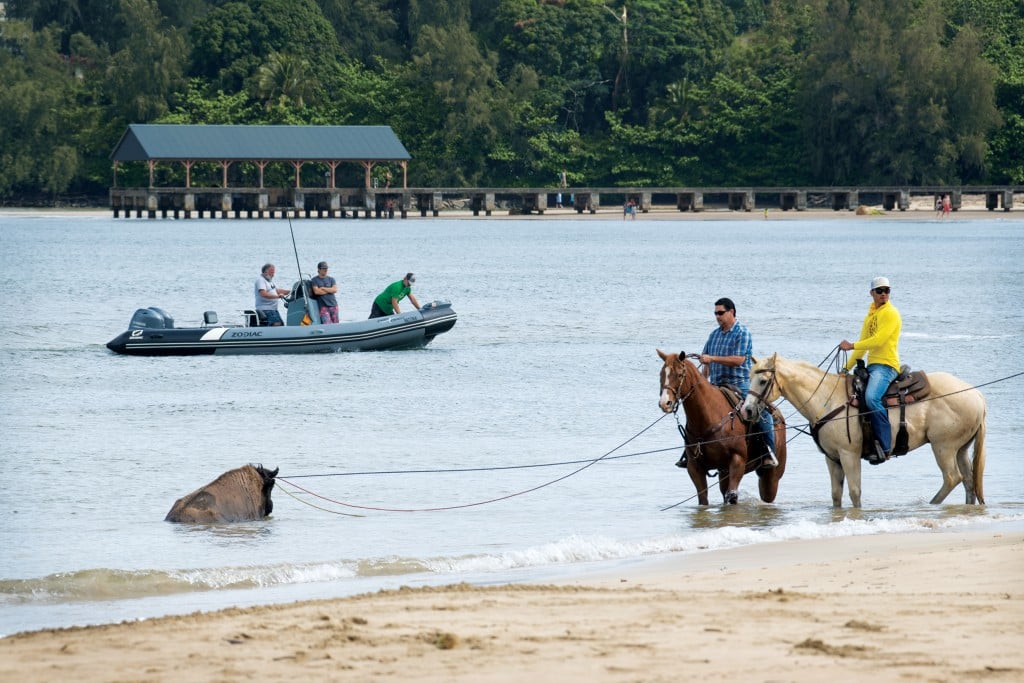
Ranchers attempt to rescue a bison from Hanalei Bay after the April 15 flooding on Kauai. | Photo: Courtesy of Matthew Roth, CC-BY
Keep Each Number in Context
When discussing costs, numbers can be powerful in that they are easy to quote. But it’s also easy to decontextualize them and use them inappropriately.
For example, Lemmo, the DLNR administrator, stresses that the $19 billion in the sea level rise report is significant not just in terms of what it includes, but what it leaves out.
“It doesn’t account for the impact to our visitor economy or to our natural resources, or the impact to our roads and other infrastructure. There are so many things that we were not able to monetize in this report, just because it would have taken eons to be able to do that.
“My point is people need to understand that, yes, this is $19 billion. But the actual economic impact is many, many, many, many, many times more significant,” says Lemmo.
Aalto, the Sierra Club Oahu chair emeritus, highlights a specific phrase in the report.
“It says that they haven’t put a number on many other associated costs. But it does say that it will be an order of magnitude greater. And people need to understand what order of magnitude greater means. It means you multiply by 10. So what they are saying is that they are anticipating the costs are going to be at least $190 billion.
“To me, that’s the shocking number that people aren’t focused enough on,” Aalto adds, noting that Hawaii’s total annual budget is only one-thirteenth of that.
Another number that must be contextualized is the 3.2-foot rise in sea levels by the end of the century, which is currently used informally as a planning target by the state of Hawaii, and now formally by the City and County of Honolulu. Scientists now say that if carbon dioxide emissions continue unabated and we take into account the melting of Antarctica, this number could be higher. For critical infrastructure with long expected lifespans and low-risk tolerance, the Honolulu Climate Change Commission recommends planning for a 6-foot rise by the latter decades of the century. These guidelines are consistent with findings by the Intergovernmental Panel on Climate Change and NOAA. Even the Trump administration, not known for its concern with climate change, released a report late last year that warns of a worst-case scenario of 8 feet.
“Ever since we started this report, what I’m seeing is that all of the predictions are coming into focus. We picked 3.2 feet and said it could happen as soon as midcentury. But for long-lasting projects like rail, we should be looking at 6 feet,” says Lemmo.
Aalto argues it’s the numbers we don’t know yet that should have people worried the most. “If they are already telling us 3.2 feet is going to cost us $190 billion and up, what will the costs be for 6 feet? We have to come to grips with this. We have to. We have to start planning.”
Account for Things That Don’t Have Price tags
Rosie Alegado has been reading through newspaper articles dating back to 1834 written in Hawaiian mostly by Hawaiians. She finds accounts of how people throughout Hawaii’s history expressed the value of the natural environment, and what they feared could be lost.
“At its simplest terms, it’s about well-being, which is a very intangible concept. Well-being from the point of view of ‘Can I catch enough fish? Do we have enough resources to build my house in a traditional way? Can I continue to get everything I need for my child’s birthday or wedding? Can I go to the same places my parents went to and do the same things? Can we continue to live life the way we always have?’ ” says Alegado, who is an assistant professor in the UH Mānoa Department of Oceanography and UH Sea Grant Program, and a member of the Honolulu Climate Change Commission.
What Alegado and others emphasize is the need to account for things that aren’t normally measured by dollars.
Kirsten Oleson, assistant professor at UH Manoa’s Department of Natural Resources and Environmental Management, also believes that emotional well-being belongs in any discussion of the costs of climate change. “My interest is not just about tourists coming and spending dollars. Those are real issues and important numbers. But I’m looking at quality of life. If we don’t acknowledge in our policies the various pieces of the system that make us happy people, and we don’t think about the effects across the whole system, we’ll lose something and we won’t know why.”
Oleson describes ecosystem services as benefits that humans freely gain from the natural environment. These include tangible things like food and water, but also things that are important yet often taken for granted.
“We’re talking about the warm-glow feeling of going hiking in native forests, or in teaching keiki how to fish. These are reliant on the environment being in a healthy state. That’s a key factor we don’t think about enough,” says Oleson.
Climate change may also disproportionately affect indigenous populations. In Hawaii, warming temperatures threaten the cultivation of taro and other traditional crops. Sea level rise impacts fishpond maintenance, nearshore fishing and salt cultivation, as well as hundreds of cultural sites by the coast.
“If we allow for that level of sacrifice, we don’t see the long-term impact on communities as a whole. We tend to see vulnerable communities as this distinct other, but we’re all one community. And an impact on one part is going to hurt all of us,” says Maxine Burkett, professor at the William S. Richardson School of Law.
How do we include these things into our cost analyses if we can’t put a price tag on them? UH Mānoa economics graduate student Marcus Peng discusses the risks: “We get a lot of enjoyment and derive a lot of benefits from the natural resources that are around us – things like clear water, recreation, fishing. All of these things have some value.
“Because they are free, what happens is that people don’t value them in the market economy. What if there’s some competing use for that beach, like someone does a cost benefit analysis and says it’s worth X million dollars to their property if there’s a seawall. The recreation value and any other value people derive from having a nice sandy beach is not incorporated in the analysis. If you don’t have some sort of dollar amount to make a trade-off decision, then very often the quantified argument wins,” says Peng.
Oleson suggests there should be room in our economic analyses for different, culturally specific measures. “Valuation doesn’t have to be monetized. You can use other methods, like tons of fish or number of days people can go fishing with their kids. Or getting even more creative,” she says, citing a study done around the benefits of a flowing river to an indigenous community, “you can talk about it in terms of the flow. What is it about the flow? Can you hear the flow, or has the river been silenced. And so the metric they landed on was the ability to hear the river from X meters away.”
For Burkett, not forgetting the enormity of the questions we’re asking can help us remember that ultimately, these are not just spreadsheet exercises.
“We plug numbers in these cost analyses and use that to answer questions. But what we’re really trying to do is tackle issues that we have traditionally relied on religion, ethics and philosophy to answer. This requires us to have meaningful conversations in all sorts of spaces. It requires us to understand why this is the right thing to do for equity and security.”
She adds, “We put a price tag on so many things. But the most important things really are priceless.”
Understand that the Economy and the Environment can work Together
An analysis of the costs associated with climate change is not complete without accounting for the ways in which the economy, in response to climate change, can also grow. Hawaii has become an innovation center for hydrogen powered vehicles, seawater air conditioning, renewable energy battery storage systems, microgrids, hydroponics, aquaculture, watershed management and other entrepreneurial or nonprofit ideas that seek to replace what we lose with what we can gain.
These efforts are supported from the top. In 2015, Gov. David Ige committed the state to using 100 percent renewable sources to generate all of our electricity by 2045. In 2016, Hawaii was the first state to enact legislation implementing parts of the Paris agreement on climate change. And earlier this year, Ige signed a bill committing the state to becoming fully carbon neutral, also by 2045.
“In other words, we are moving toward a decarbonized economy and this is exactly what the world needs to do if we’re going to keep the global temperature rise below 2 degrees Celsius, as called for in the Paris climate treaty,” says Fletcher, the Honolulu Climate Change Commission vice chair.
To that end, clean energy companies have raised over $350 million in follow-up funding, support 55 direct jobs in the startup ecosystem and account for over 15,000 jobs across the state, says Dawn Lippert, CEO of the Elemental Excelerator, which supports innovative clean energy startups.
She adds that, contrary to the stereotype, the majority of clean energy jobs are not for Ph.D.s and MBAs. “Of the million and a half solar jobs in the country, most are electricians, technicians, roofers and other blue-collar jobs. When people think of the innovation economy, they should absolutely include these trade jobs,” says Lippert.
Kunoa Cattle is adding livestock farming to the equation. Its Kauai and Oahu ranches raise cattle using techniques that improve soil quality. Healthier soil can hold more water and nutrients, mitigating some effects of drought.
“As a ranchhand in Colorado, I observed that if cattle are well managed, they can regenerate landscapes. I thought wow, this is really powerful. And if I can find a way to turn this into a business, we can use capitalism to reverse climate change. That’s what I’m passionate about,” says co-founder Jack Beuttell.
Earlier this year, Ige also signed a bill requiring companies that emit more than a certain amount of carbon to either reduce their emissions through energy efficient practices or, if they can’t, purchase carbon credits. These credits are used to rebuild forests. The trees, in turn, create multiple benefits, including pulling carbon out of the atmosphere, capturing rainfall that replenishes our aquifers, protecting indigenous species and reducing rainfall runoff.
“One of the things we’re focused on is how to have the environment and economy work together – not be seen as opposites or come at the cost of each other,” says state Office of Environmental Quality Control director Scott Glenn. “In this case, we’re trying to turn what’s a cost into a revenue, (or) at least balance it out. It’s not the be-all end-all solution, but it’s a step in the right direction. We need to reforest Hawaii. If we can generate revenue to do it, so much the better.”
Experts interviewed for this piece say there simply is no way to talk about Hawaii’s future financial balance sheets without talking about the health of our natural resources. “To many people, the environment is not a high importance issue – it’s not among the things that drives their votes,” says Fletcher. “But a ruined environment in Hawaii will result in a ruined economy. It won’t happen all at once. It will be a slow erosion if we continue to do a poor job of preserving the environment. The economy is going to pay and also the quality of life of residents will decline as well.
“What we must understand is that the economy is the environment.”


